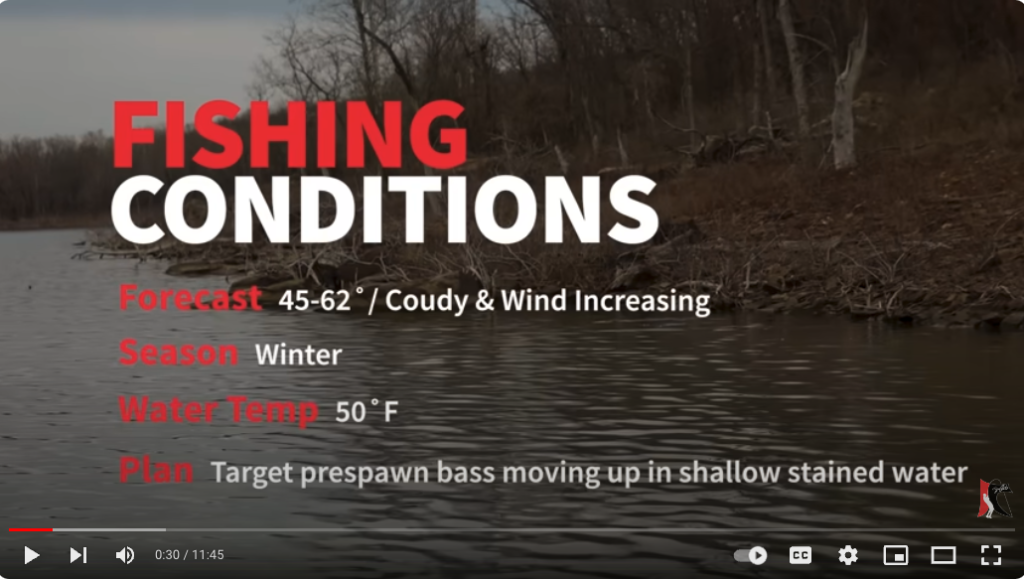by Jason Christie
2/21/2024
Conditions:

Jason Christie’s video is a comprehensive guide on early spring bass fishing, focusing on using spinnerbaits, lipless crankbaits, and square bills in conditions where the water has recently warmed up and gained some color. Here’s a detailed breakdown of the strategies, techniques, and insights he shares:
Conditions and Setup
- Weather and Water Conditions: Christie begins by noting a significant warm-up in weather and water temperature, with a 10-degree increase leading to a section of the lake gaining color. These conditions are ideal for moving away from deep water and finesse techniques to more aggressive, bank-oriented approaches.
- Lure Selection: He primarily focuses on a spinnerbait due to the stained water conditions but also mentions the potential use of a lipless crankbait (specifically a one-knocker) and a square bill crankbait for areas where the water might be clearer.
Spinnerbait Fishing
- Technique: Christie emphasizes slow-rolling the spinnerbait, aiming to keep it close to the bottom without actually dragging it. He highlights the importance of adjusting the retrieve based on the contour of the lake bed, allowing the bait to naturally follow the terrain.
- Blade Choice: A key point is his preference for a Colorado blade on the spinnerbait, which provides lift and allows for a slower retrieve in the colder, stained water. The blade choice is influenced by water temperature and clarity, with Colorado blades being favored in colder, murkier conditions for their ability to attract fish through vibration.
- Bite Indicators: He describes the bites as subtle, sometimes feeling like a stick or noticing the blade stop spinning. This indicates the need for heightened sensitivity and awareness during the retrieve.
Adjusting to Conditions
- Wind and Water Clarity: Christie notes that wind could further muddy the water, making conditions even more favorable for spinnerbait fishing. He stresses the importance of adapting lure choice and technique to the clarity of the water and the presence of wind.
- Water Temperature: The recent spike in water temperature is a critical factor, suggesting that bass are beginning to move shallower, though not necessarily to spawn, but to start positioning near spawning areas.
Lure Presentation
- Depth and Speed: The presentation of the spinnerbait is crucial, with Christie aiming to keep the bait just above the bottom. He discusses the importance of a slow retrieve speed, given the water temperature is still in the high 40s (Fahrenheit).
- Following the Contour: A significant part of his strategy involves understanding and following the lake’s contour, especially when transitioning from shallow to deeper areas or vice versa. He uses forward-facing sonar (LiveScope) to gauge the bottom’s structure, ensuring the spinnerbait is presented effectively across different depths.
Insights on Bass Behavior
- Early Movers: Christie suggests that the bass moving shallow early in the season are often larger fish. He points out that while the number of bites may be lower than fishing in deeper water, the quality of the fish caught is generally higher.
- Observations with LiveScope: Although primarily focusing on spinnerbait fishing, Christie acknowledges the value of LiveScope for identifying bottom contours and structure, even if not used directly to spot fish for this particular technique.
Concluding Thoughts
- Jason Christie’s approach to early spring bass fishing with spinnerbaits is both methodical and adaptable, emphasizing the importance of lure selection, presentation, and understanding changing water conditions. His insights provide valuable lessons on targeting larger bass as they begin to move shallow with the warming trends, offering a blend of traditional angling wisdom and modern sonar technology to maximize success during this transitional period.

